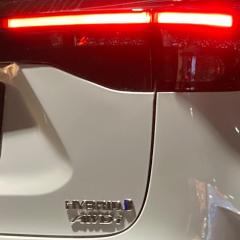Leaderboard
Popular Content
Showing content with the highest reputation on 06/28/2013 in all areas
-
Introduction As requested by a few members on this forum. This is our account on how we replaced the tailgate on my RAV4 to the version which has the spare wheel mounting option. Please understand that we are not mechanically trained, or qualified. So, any comments are welcome, especially if we have made any mistakes, missed anything important, or just require further info. Chapter Two – Number plate Tools required/used : None Cost this chapter : £352 Cost to date : £872 Because the spare wheel would now be where the number plate had been before, a new location for it was required. These are the options we came up with : Option A : Attach a mounting plate to the existing rear bumper. Option B : Change the rear bumper to the same type as found on existing cars with the spare wheel on the tailgate. Option C : Change tailgate ‘garnish’ panel. ( Not sure whether a standard size number plate would fit the space. ) Option D : Attach a skirt to the existing rear bumper. We chose option “D”, to use a rear skirt. Rear skirt : £280 inc p&p - New Toyota part number TPZ439-X0460-AB Number plate lights to fit skirt. Number plate lights : £22 inc p&p – New Toyota part number 81271-42050 Replacement sub-loom with connections for number plate lights, AND fog lights. Sub loom : £50 inc p&p – Second hand from internet auction site ( Or £68 – New Toyota part number 99999-99999 ) On our RAV, where the rear bumper sub-loom joined the main body loom, there was three pins in the connector. The three pins are, PIN1-Earth PIN2-Fog Lights Pin3-Number plate lighting. The old sub-loom only used PIN1 & PIN2, the new sub-loom uses PIN1, PIN2 & PIN3. The connector is located behind the bumper, on the near side corner.1 point
-
Madness not to change the tensioner as well. Also consider a new water pump if you are paying someone else to do the job as they are not that expensive compared with the labour costs of stripping it all down again if it lets go. If you are doing it yourself then you could leave the pump if it is OK as you could sort it out yourself if needed later.1 point
-
1 point
-
There are many RAV4's in the UK which were imported from Ireland over the years - most Irish RAV's up to 2012 had a door mounted spare wheel as standard. There are detailed differences between UK and Irish models but essentially they're the same car and carry the same warranty. Several 2012 model RAV's appeared on Ebay earlier this year at around £19500 new on the road. See pictures of a typical 2012 imported model RAV in the link below http://www.carzone.ie/search/Toyota/Rav4/RAV4-2.2/31713595621452090/advert?channel=CARS1 point
-
With the headlights on, press and hold the button below the speedometer to adjust the brightness. Display should show up to five bars or a block of dashes. Five bars is the brightest. Dashes are the dimmest1 point
-
that's what I was replying too. It seems anecdotally (for Toyota aren't saying publicly) that the T180s maybe worst affected, followed by the 150bhp 2.2s & then the 2.0s. You may want to read http://www.toyotaownersclub.com/forums/index.php?app=core&module=attach§ion=attach&attach_id=10987 although we know that guidelines have changed since then.1 point
-
It would have been for an Austin 1100. But it was about 1969 and I haven't the faintest idea how much it was. Probably about £15/10s/6d1 point
-
You have to add more than 15 litres of fuel for the range meter to recalculate. £10 is but a dribble nowadays it is a function in the fuel computer.1 point
-
I have experienced very similar symptoms on a Mazda MX5. Sometimes ran fine but other times it would start ok then either stall and refuse to start or started but not all cylinders firing. No fault code showed up. Coils on that model are a known weakness but experts suggested coil would either work or not rather than be an intermittent fault. After changing a few sensors with no joy I eventually replaced the coil pack and it has been perfect ever since. Decision was made easier for me due to it being a known issue.....dont know if there is any history of coils being a problem on petrol Ravs? Just a thought.1 point
-
I would try a bottle of injector cleaner through it. I've had miraculous results with it in the past.1 point
-
http://www.babcox.com/editorial/ic/ic30121.htm Anti-Lock Brake System Service: Focus On Toyota Corolla Models, Larry Carley, ImportCar, March 2001 The anti-lock brake system used on older Toyota Corolla models is essentially the same as that on the Camry, Celica and other Toyota models: A Bosch 2 non-integral design with four wheel speed sensors and a separate hydraulic control circuit for each wheel. In 1992, the Corolla used a hydraulic modulator with four 3-position solenoid valves (the same as the Camry and Celica). The ABS control module was located under the instrument panel (See Fig. 1). Starting in 1993, the Corolla was equipped with a new hydraulic modulator (actuator) that has eight 2-position solenoid valves. The ABS control module is also mounted on the modulator assembly and can be replaced separately, if defective. The newer modulator also has a pump motor to recirculate fluid back to the master cylinder when brake pressure is being reduced during an ABS stop. Like other ABS systems, the eight solenoid valves in the ‘93 and newer modulator isolate, decrease or maintain brake fluid pressure in each individual wheel circuit as needed during an ABS stop. There are four inlet solenoid valves to isolate and hold pressure in each brake circuit, and four outlet solenoid valves to decrease pressure. The normal position of the inlet valves is open, while the normal position of the outlet valves is closed. Each wheel has its own wheel speed sensor, and all are the traditional magnetic type that generate an AC signal that increases both frequency and amplitude with wheel speed. Sensors are removable but do not have an adjustable air gap. TROUBLESHOOTING The ABS warning lamp should come on for a bulb check when the ignition is first switched on, then go out if no faults have been detected. However, if the lamp remains on, it means the system has detected a fault and deactivated the ABS system. Fortunately, Toyota provides flash codes to read the ABS codes on the Corolla. To check the codes, turn on the ignition, remove the short pin from the ABS check connector (See Fig. 2) and use a jumper to connect terminals Tc and E1. If the ABS light blinks at a constant rate of two times per second, there are no fault codes stored in memory. That doesn’t necessarily mean everything is OK because something may be having an adverse affect on the operation of the ABS system. This includes low battery voltage, a "dirty" wheel speed sensor that is not giving a reliable reading or a hydraulic problem in the modulator assembly (See. Fig. 4). If there are one or more stored codes in memory, the ABS will flash the first two-digit code, then the next and so on, repeating the code(s) as long as the check connector is jumped. The first number of flashes equals the first digit of the code. After a 1.5-second pause, the second number of flashes equals the second digit of the code. If there’s more than one code, there will be a 2.5 second pause before the next two-digit code flashes out. TOYOTA ABS CODES 11 — Open shorted relay circuit. Check modulator wiring harness, solenoid relay, solenoid relay wiring harness and solenoid relay connector. 12 — Short in solenoid relay circuit. Check modulator wiring harness, solenoid relay, solenoid relay wiring harness and solenoid relay connector. 13 — Open pump motor relay circuit. Check modulator wiring harness, pump motor wiring harness, pump motor relay circuit and pump motor connector. 14 — Short in pump motor relay circuit. Check modulator wiring harness, pump motor wiring harness, pump motor relay circuit and pump motor connector. 21 — Open or short in ABS solenoid for right front wheel. 22 — Open or short in ABS solenoid for left front wheel. 23 — Open or short in ABS solenoid for right rear wheel. 24 — Open or short in ABS solenoid for left rear wheel. 31 — Problem in right front wheel speed sensor circuit. 32 — Problem in left front wheel speed sensor circuit. 33 — Problem in right rear wheel speed sensor circuit. 34 — Problem in left rear wheel speed sensor circuit. 35 — Open in left front or right rear wheel speed sensor (WSS) circuit. 36 — Open in right front or left rear WSS circuit. 37 — Faulty rear speed sensor rotor. 41 — Battery voltage too low or high (under 9.5 volts or over 16.2 volts). Check battery and charging system. 51 — Pump motor is locked or pump motor circuit is open. Check pump motor, motor relay, wiring harness and modulator ground connections. "Always on" (no flash codes, just a steady light) — Malfunction of ABS module. To clear fault codes, leave the jumper in place between terminals Tc and E1 with the key on, then pump the brake pedal eight or more times in three seconds or less. When codes are erased, the ABS light should flash two times per second. SPECIAL WSS TEST MODE If you’ve found a fault code for a wheel speed sensor, it may be due to an open or short in the sensor’s wiring harness, physical damage to the sensor or sensor ring, a buildup of metallic debris on the sensor tip or corrosion. Toyota provides a special wheel speed sensor diagnostic procedure that can generate additional codes to help you diagnose the underlying fault. Though this test is really redundant, it may help you isolate a troublesome wheel speed sensor. To enter the special WSS test mode, turn off the ignition. Leave the short pin in the ABS check connector and use a jumper wire to connect terminals Ts and E1. Engage the parking brake and start the engine. If the system is in the special diagnostic mode, the ABS light will flash at a rate of four times per second. Drive the vehicle straight ahead at a speed above 50 mph. The ABS light will stop blinking as soon as you exceed 28 mph, then blink once when you hit 50 mph. As soon as you’ve seen the blinks, the test is complete and you can stop the vehicle. To retrieve the wheel speed sensor codes, use the same diagnostic procedure that you would use to read the normal ABS codes. Remove the short pin from the ABS check connector and jump Tc to E1. If a problem was detected in any of the wheel speed sensor circuits, you’ll find one or more of the following codes: 71 — Low voltage in right front WSS circuit. 72 — Low voltage in left front WSS circuit. 73 — Low voltage in right rear WSS circuit. 74 — Low voltage in left rear WSS circuit. 75 — Abnormal signal from right front speed sensor. Check the sensor ring on the right front brake rotor for damage or debris. 76 — Abnormal signal from the left front speed sensor. Check the sensor ring on the left front brake rotor for damage or debris. 77 — Abnormal signal from the right rear speed sensor. Check the sensor ring on the right rear brake. 78 — Abnormal signal from the left rear speed sensor. Check the sensor ring on the left rear brake. Light blinks four times a second — No problem found. All speed sensors are reading normal. WSS CHECKS To measure a wheel speed sensor’s output voltage and circuit continuity at the same time, plug a breakout box into the ABS module’s wiring harness and attach the test leads from a DVOM to the appropriate sensor circuit pins on the breakout box. (Note: The DVOM test leads can also be connected directly to the wheel speed sensor, but testing the sensor this way won’t show if the signal is getting through to the ABS control module or not.) Spin the wheel by hand and note the sensor’s voltage reading during that time. A good wheel speed sensor will generally produce an alternating current (AC) voltage reading of 50 to 700 MV when the wheel is spun at a speed of about one revolution per second. If the voltage reading is low or nonexistent, check the sensor’s resistance (with the key off). This can be done through the breakout box with the DVOM. Checking resistance through the breakout box will tell you if the sensor’s wiring harness is OK. If the wheel speed sensor doesn’t read between 990 to 1210 ohms, disconnect the sensor from its wiring harness and check the sensor’s resistance by attaching the DVOM test probes to the sensor leads. A resistance reading that’s now within range tells you the problem is in the wiring, not the sensor. If the sensor has too much internal resistance (opens) or too little resistance (shorts), the sensor is defective and needs to be replaced. Grounds or shorts in the wheel speed sensor cables can be found by checking continuity between the wiring connectors. (See Fig. 3). If a defect is found in the wires that run between the sensor and the chassis, replacing the wires with new ones is a better repair choice than trying to fix or splice them. These wires undergo a great deal of flexing every time the suspension encounters a bump, so new wires will hold up better than ones that have been soldered, spliced or taped. Another way to check wheel speed sensors is with an oscilloscope. By displaying the sensor’s output pattern graphically on the scope screen, you can often see problems that are difficult to find otherwise. A missing or damaged tooth on a sensor ring, for example, may not produce a noticeable change in the sensor’s output voltage. Yet, the fluctuation that occurs in the signal every time the missing tooth passes under the tip of the sensor may be enough to affect the operation of the ABS module. The scope connection can either be made through the breakout box or it can be hooked up directly to the wheel speed sensor. A scope pattern for a wheel speed sensor should show a classic sine wave alternating current pattern that changes both in frequency and amplitude with wheel speed. As the wheel is turned faster, both signal frequency and amplitude should increase. Damaged or missing teeth on the sensor ring will show up as flat spots or gaps in the sine wave pattern. A bent axle or hub will produce an undulating pattern that changes as the strength of the sensor signal changes with every revolution. If the scope pattern produced by the sensor is flattened (diminished amplitude) or erratic, it usually indicates a weak signal caused by an excessively wide air gap between the tip of the sensor and its ring, or a build up of metallic debris on the end of the sensor. A weak signal can also be caused by internal resistance in the sensor or its wiring circuit, or loose or corroded wiring connectors.1 point
-
I just printed it as a PDF and will attach it to this post - that way if that site ever disappears it will still exist. Moderators feel free to attach it to the pinned bit ToyotaABS.pdf1 point






